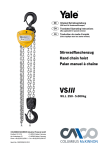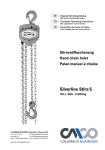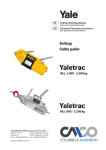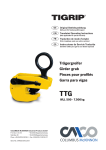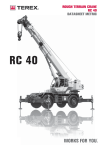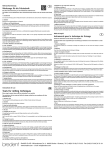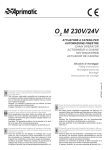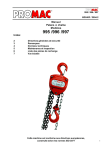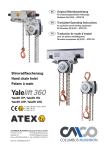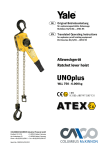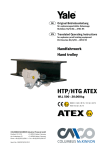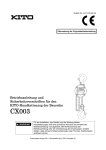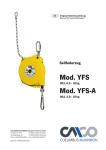Download Yalelift 360
Transcript
DE Original Betriebsanleitung (Gilt auch für Sonderausführungen) EN Translated Operating Instructions (Also applicable for special versions) FR Traduction de mode d’emploi (Cela s’applique aussi aux autres versions) Stirnradflaschenzug Hand chain hoist Palans à main W L L 500 - 20.000 kg COLUMBUS McKINNON Industrial Products GmbH • D-42301 Wuppertal, Germany P. O. Box 11 01 53 • D-42329 Wuppertal, Germany Yale-Allee 30 Phone +49 (0) 202/6 93 59-0 • Fax + 49 (0) 202 / 6 93 59-127 Ident.-No.: 09901068/02.2014 DE Seite 2 EN Page 6 FR Page 10 Deutsch DE VORWORT Produkte der CMCO Industrial Products GmbH sind nach dem Stand der Technik und den anerkannten gültigen Regeln gebaut. Durch unsachgemäße Handhabungen können dennoch bei der Verwendung der Produkte Gefahren für Leib und Leben des Benutzers oder Dritter auftreten bzw. Beschädigungen am Hebezeug oder anderen Sachwerten entstehen. Der Betreiber ist für die sach- und fachgerechte Unterweisung des Bedienpersonals verantwortlich. Dazu ist die Betriebsanleitung von jedem Bediener vor der ersten Inbetriebnahme sorgfältig zu lesen. Diese Betriebsanleitung soll erleichtern, das Produkt kennenzulernen und die bestimmungsgemäßen Einsatzmöglichkeiten zu nutzen. Die Betriebsanleitung enthält wichtige Hinweise, um das Produkt sicher, sachgerecht und wirtschaftlich zu betreiben. Ihre Beachtung hilft Gefahren zu vermeiden, Reparaturkosten und Ausfallzeiten zu vermindern und die Zuverlässigkeit und Lebensdauer des Produktes zu erhöhen. Die Betriebsanleitung muss ständig am Einsatzort des Produktes verfügbar sein. Neben der Betriebsanleitung und den im Verwenderland und an der Einsatzstelle geltenden verbindlichen Regelungen zur Unfallverhütungsvorschrift sind auch die anerkannten Regeln für sicherheits- und fachgerechtes Arbeiten zu beachten. Das Personal für Bedienung, Wartung oder Reparatur des Produktes muss die Anweisungen in dieser Betriebsanleitung lesen, verstehen und befolgen. Die beschriebenen Schutzmaßnahmen führen nur dann zu der erforderlichen Sicherheit, wenn das Produkt bestimmungsgemäß betrieben und entsprechend den Hinweisen installiert bzw. gewartet wird. Der Betreiber ist verpflichtet, einen sicheren und gefahrlosen Betrieb zu gewährleisten. 2 von 20 BESTIMMUNGSGEMÄSSE VERWENDUNG - Das Gerät dient dem vertikalen Heben und Absenken von Lasten bis zur angegebenen maximalen Tragfähigkeit. In Kombination mit einem Fahrwerk können Lasten auch horizontal verfahren werden. - Eine andere oder darüber hinausgehende Benutzung gilt als nicht bestimmungsgemäß. Für hieraus resultierende Schäden haftet Columbus McKinnon Industrial Products GmbH nicht. Das Risiko trägt allein der Anwender bzw. Betreiber. - Die auf dem Gerät angegebene Tragfähigkeit (WLL) ist die maximale Last, die angeschlagen werden darf. - Sollte das Hebezeug zum häufigen Ablassen aus großen Höhen oder im Taktbetrieb eingesetzt werden, ist wegen evtl. Überhitzung zuvor mit dem Hersteller Rücksprache zu halten. - Sowohl der Trag- als auch der Lasthaken des Gerätes muss sich im Moment des Anhebens der Last in einer Lotrechten über dem Schwerpunkt (S) der Last befinden, um ein Pendeln der Last beim Hebevorgang zu vermeiden (Fig. 1). - Die Auswahl und Bemessung der geeigneten Tragkonstruktion obliegt dem Betreiber. - Beim Einhängen des Gerätes ist vom Bediener darauf zu achten, dass das Hebezeug so bedient werden kann, dass der Bediener weder durch das Gerät selbst noch durch das Tragmittel oder die Last gefährdet wird. - Der Bediener darf eine Lastbewegung erst dann einleiten, wenn er sich davon überzeugt hat, dass die Last richtig angeschlagen ist und sich keine Personen im Gefahrenbereich aufhalten. - Der Aufenthalt unter einer angehobenen Last ist verboten. - Lasten nicht über längere Zeit oder unbeaufsichtigt in angehobenem oder gespanntem Zustand belassen. - Das Hebezeug kann in einer Umgebungstemperatur zwischen –10 °C und +50 °C eingesetzt werden. Bei Extrembedingungen muss mit dem Hersteller Rücksprache genommen werden. ACHTUNG: Bei Umgebungstemperaturen unter 0°C vor Benutzung durch 2-3maliges Anheben und Absenken einer kleinen Last überprüfen, ob die Bremse vereist ist. - Vor dem Einsatz des Hebezeuges in besonderen Atmosphären (hohe Feuchtigkeit, salzig, ätzend, basisch) oder der Handhabung gefährlicher Güter (z.B. feuerflüssige Massen, radioaktive Materialien) ist mit dem Hersteller Rücksprache zu halten. - Der horizontale Transport des Hebegutes sollte immer langsam, vorsichtig und bodennah durchgeführt werden. - Bei Nichtbenutzung des Gerätes ist das Tragmittel (z.B. Unterflasche, Haken) möglichst über Kopfhöhe zu positionieren. - Zum Anschlagen einer Last dürfen nur zugelassene und geprüfte Anschlagmittel benutzt werden. - Zur bestimmungsgemäßen Verwendung gehört neben der Beachtung der Betriebsanleitung auch die Einhaltung der Wartungsanleitung. - Bei Funktionsstörungen oder abnormalen Betriebsgeräuschen ist das Hebezeug sofort außer Betrieb zu setzen. SACHWIDRIGE VERWENDUNG (Nicht vollständige Auflistung) - Die Tragfähigkeit des Gerätes (WLL) bzw. des Tragmittels sowie der Tragkonstruktion darf nicht überschritten werden. - Das Gerät darf nicht zum Losreißen festsitzender Lasten verwendet werden. Es ist ebenso verboten, eine Last in die schlaffe Lastkette fallen zu lassen (Gefahr des Kettenbruchs). - Das Entfernen oder Verdecken von Beschriftungen (z.B. durch Überkleben), Warnhinweisen oder dem Typenschild ist untersagt. - Beim Transport der Last ist eine Pendelbewegung (Fig. 2) und das Anstoßen an Hindernisse zu vermeiden. - Die Last darf nicht in Bereiche bewegt werden, die für den Bediener nicht einsehbar sind. Nötigenfalls hat er sich um Hilfestellung zu bemühen. - Motorischer Antrieb des Gerätes ist verboten. - Das Gerät darf niemals mit mehr als der Kraft einer Person bedient werden. - Schweißarbeiten an Haken und Lastkette sind verboten. Die Lastkette darf nicht als Erdungsleitung bei Schweißarbeiten verwendet werden (Fig. 3). - Schrägzug, d.h. seitliche Belastungen des Gehäuses oder der Unterflasche, ist verboten (Fig. 4). - Die Lastkette darf nicht als Anschlagkette (Schlingkette) verwendet werden (Fig. 5). - Ein ohne Rücksprache mit dem Hersteller verändertes Gerät darf nicht benutzt werden. - Die Benutzung des Hebezeuges zum Transport von Personen ist verboten (Fig. 6). - Lastkette nicht knoten oder mit Bolzen, Schraube, Schraubendreher oder Ähnlichem verbinden. Fest in Hebezeugen eingebaute Lastketten dürfen nicht instandgesetzt werden (Fig. 7). - Das Entfernen der Sicherheitsbügel von Trag- bzw. Lasthaken ist verboten (Fig. 8). - Hakenspitze nicht belasten (Fig. 9). Das Anschlagmittel muss immer im Hakengrund aufliegen. - Das Kettenendstück (Fig. 11) darf nicht als betriebsmäßige Hubbegrenzung verwendet werden. - Ein betriebsmäßiges Drehen der aufgenommenen Lasten ist verboten, da die Unterflasche des Gerätes dafür nicht konzipiert ist. Ist ein betriebsmäßiges Drehen vorgesehen, müssen sog. Drallfänger eingesetzt werden bzw. es ist mit dem Hersteller Rücksprache zu halten. - In den Lasthaken des Hebezeuges darf nur ein einzelnes Lastaufnahmemittel gehängt werden. - Niemals in bewegliche Teile greifen. - Gerät nicht aus großer Höhe fallen lassen. Es sollte immer sachgemäß auf dem Boden abgelegt werden. - Das Gerät darf nicht in explosionsfähiger Atmosphäre eingesetzt werden (Sonderausführungen auf Anfrage). Hebezeug in einem sicheren Zustand befindet, ordnungsgemäß aufgestellt und betriebsbereit ist und gegebenenfalls Mängel bzw. Schäden festgestellt und behoben werden. *Als befähigte Personen können z.B. die Wartungsmonteure des Herstellers oder Lieferanten angesehen werden. Der Unternehmer kann aber auch entsprechend ausgebildetes Fachpersonal des eigenen Betriebes mit der Prüfung beauftragen. Vor der Inbetriebnahme ist die Funktion des Kettentriebes im unbelasteten Zustand zu testen. PRÜFUNG VOR ARBEITSBEGINN Vor jedem Arbeitsbeginn ist das Gerät einschließlich der Tragmittel, Ausrüstung und Tragkonstruktion auf augenfällige Mängel und Fehler wie z.B. Verformungen, Anrisse, Verschleiß und Korrosionsnarben zu überprüfen. Weiterhin sind die Bremse und das korrekte Einhängen des Gerätes und der Last zu überprüfen. MONTAGE Verlängerung bzw. Kürzung der Handkette Die Länge der Handkette soll so eingestellt werden, dass der Abstand des unteren Endes zum Boden zwischen 500 mm und 1000 mm beträgt. Hinweis: Aus Sicherheitsgründen dürfen Handkettenverbindungsglieder nur einmal verwendet werden. - Nicht verschweißtes Kettenglied in der Handkette suchen, durch Verbiegen öffnen und entsorgen. - Kette auf die gewünschte Länge verkürzen bzw. verlängern. Bremsfunktion prüfen Vor Arbeitsbeginn unbedingt die Funktion der Bremse prüfen: Dazu ist mit dem Gerät eine Last über eine kurze Distanz zu heben, zu ziehen oder zu spannen und wieder abzusenken bzw. zu entlasten. Beim Loslassen der Handkette muss die Last in jeder beliebigen Position gehalten werden. Diese Überprüfung soll sicherstellen, dass auch bei Temperaturen unter 0 °C die Bremsscheiben nicht vereist sind. Sie ist mindestens zweimal zu wiederholen, bevor mit der weiteren Arbeit begonnen wird. ACHTUNG: Es muss immer eine gerade Anzahl von Kettengliedern entfernt bzw. hinzugefügt werden. ACHTUNG: Bei Funktionsstörung der Bremse ist das Gerät sofort außer Betrieb zu setzen und Rücksprache mit dem Hersteller zu halten! - Mit neuem Verbindungsglied die losen Kettenenden durch Verbiegen schließen (beim Verlängern der Handkette werden zwei neue Verbindungsglieder benötigt). ACHTUNG: Handketten bei der Montage nicht in sich verdrehen. Überprüfung des Anschlagpunktes - Der Anschlagpunkt für das Hebezeug ist so zu wählen, dass die Tragkonstruktion, an der es montiert werden soll, eine ausreichende Stabilität besitzt und die zu erwartenden Kräfte sicher aufgenommen werden können. - Es ist dafür zu sorgen, dass sich das Gerät auch unter Last frei ausrichten kann, da sonst unzulässige Zusatzbelastungen auftreten können. - Die Auswahl und Bemessung der geeigneten Tragkonstruktion obliegt dem Betreiber. PRÜFUNG VOR DER ERSTEN INBETRIEBNAHME Vor der ersten Inbetriebnahme, vor der Wiederinbetriebnahme und nach grundlegenden Änderungen ist das Produkt einschließlich der Tragkonstruktion einer Prüfung durch eine befähigte Person* zu unterziehen. Diese Prüfung besteht im Wesentlichen aus einer Sicht- und Funktionsprüfung. Diese Prüfungen sollen sicherstellen, dass sich das Überprüfung der Lastkette Die Lastkette muss auf äußere Fehler, Verformungen, Anrisse, Korrosionsnarben, Verschleiß und ausreichende Schmierung überprüft werden. Überprüfung des Kettenendstücks Das Kettenendstück muss unbedingt und immer am losen Kettenende montiert sein (Fig. 11). Abnutzungen bzw. Fehlstellungen dürfen nicht vorhanden sein. Überprüfung des Trag- und Lasthakens Der Trag- bzw. Lasthaken muss auf Risse, Verformungen, Beschädigungen, Abnutzung und Korrosionsnarben überprüft werden. Der Sicherheitsbügel muss leichtgängig und voll funktionsfähig sein. Überprüfung des Kettenverlaufs der Unterflasche Vor jeder Inbetriebnahme zwei- oder mehrstrangiger Geräte ist darauf zu achten, dass die Lastkette nicht verdreht oder verschlungen ist. Bei zwei- oder mehrstrangigen Geräten kann es zu einer Verdrehung z.B. dann kommen, wenn die Unterflasche umgeschlagen wurde (Fig. 10). Bei Kettenersatz ist auf richtigen Kettenverlauf zu achten (Fig. 12). Die Kettenschweißnaht muss nach außen zeigen. Es dürfen nur Lastketten eingebaut werden, die vom Hersteller zugelassen sind. Bei Nichteinhaltung dieser Vorgabe erlischt die gesetzliche Gewährleistung bzw. Garantie mit sofortiger Wirkung. FUNKTION / BETRIEB Heben der Last Durch Ziehen an der Handkette (Fig. 11) im Uhrzeigersinn wird die Last angehoben. ACHTUNG: In Abhängigkeit von der Form der aufgenommenen Last ist bei Ausführungen mit Kettenspeicher die eventuell reduzierte Hubhöhe zu beachten! Senken der Last Durch Ziehen an der Handkette (Fig. 11) entgegen dem Uhrzeigersinn wird die Last abgesenkt. Yale Überlastsicherung (optional) Die Überlastsicherung ist auf ca. 25% (±15%) Überlast eingestellt. Die Einstellung der Überlastsicherung darf nur durch eine befähigte Person erfolgen. Bei Überschreiten der Lastbegrenzung tritt die Überlastsicherung in Funktion und verhindert ein weiteres Anheben der Last, während ein Senken weiterhin möglich ist. 3 von 20 PRÜFUNG, WARTUNG UND REPARATUR Laut bestehenden nationalen/internationalen Unfallverhütungs- bzw. Sicherheitsvorschriften müssen Hebezeuge • gemäß der Gefahrenbeurteilung des Betreibers, • vor der ersten Inbetriebnahme, • vor der Wiederinbetriebnahme nach Stilllegung, • nach grundlegenden Änderungen, • jedoch mindestens 1 x jährlich durch eine befähigte Person geprüft werden. ACHTUNG: Die jeweiligen Einsatzbedingungen (z.B. in der Galvanik) können kürzere Prüfintervalle notwendig machen. Reparaturarbeiten dürfen nur von Fachwerkstätten, die Original Yale-Ersatzteile verwenden, durchgeführt werden. Die Prüfung (im Wesentlichen Sicht- und Funktionsprüfung) hat sich auf die Vollständigkeit und Wirksamkeit der Sicherheitseinrichtungen sowie auf den Zustand des Gerätes, der Tragmittel, der Ausrüstung und der Tragkonstruktion hinsichtlich Beschädigung, Verschleiß, Korrosion oder sonstigen Veränderungen zu erstrecken. Die Inbetriebnahme und die wiederkehrenden Prüfungen müssen dokumentiert werden (z.B. in der CMCO-Werksbescheinigung). Auf Verlangen sind die Ergebnisse der Prüfungen und die sachgemäße Reparaturdurchführung nachzuweisen. Ist das Hebezeug (ab 1t Hubgewicht) an oder in einem Fahrwerk eingebaut und wird mit dem Hebezeug eine gehobene Last in eine oder mehrere Richtungen bewegt, wird die Anlage als Kran betrachtet und es sind ggf. weitere Prüfungen durchzuführen. Lackbeschädigungen sind auszubessern, um Korrosion zu vermeiden. Alle Gelenkstellen und Gleitflächen sind leicht zu schmieren. Bei starker Verschmutzung ist das Gerät zu reinigen. Spätestens nach 10 Jahren muss das Gerät einer Generalüberholung unterzogen werden. Insbesondere die Maße der Lastkette, des Last- und des Traghakens bedürfen der Beobachtung. Sie sind mit den Tabellenmaßen (Tab. 2, Tab. 3) zu vergleichen. ACHTUNG: Der Austausch von Bauteilen zieht zwangsläufig eine anschließende Prüfung durch eine befähigte Person nach sich! Prüfung der Lastkette (nach DIN 685-5) Die Lastkette ist jährlich, jedoch spätestens nach 50 Betriebsstunden auf mechanische Schäden zu untersuchen. Sie muss auf äußere Fehler, Verformungen, Anrisse, Korrosionsnarben, Verschleiß und ausreichende Schmierung überprüft werden. 4 von 20 Rundstahlketten müssen ausgewechselt werden, wenn die ursprüngliche Nenndicke ´d´ am stärksten verschlissenen Kettenglied um mehr als 10 % abgenommen hat oder wenn die Kette über eine Teilung ´pn´ eine Längung von 5 % (Fig. 13) oder 11 Teilungen (11 x pn) eine Längung von 3 % erfahren hat. Die Nominalwerte und Verschleißgrenzen sind Tabelle 2 zu entnehmen. Bei Erreichen eines der Grenzwerte ist die Lastkette auszutauschen. Wartung der Lastkette Kettenverschleiß in den Gelenkstellen ist in den weitaus meisten Fällen auf ungenügende Pflege der Kette zurückzuführen. Um eine optimale Schmierung der Umlenkungen zu gewährleisten, muss die Kette in regelmäßigen, auf den Einsatz abgestimmten Zeitabständen, mit kriechfähigem Schmierstoff (z.B. Getriebeöl) geschmiert werden. Bei verschleißfördernden Umgebungseinflüssen, wie z.B. Sand etc. sollte ein Trockenschmiermittel, wie z.B. PTFE-Spray, verwendet werden. Durch eine sorgfältige Schmierung der Lastkette kann die Standzeit auf das 20- bis 30-fache gegenüber einer ungewarteten Kette verlängert werden. - Beim Schmiervorgang ist die Kette zu entlasten, damit das Öl die verschleißbeanspruchten Umlenkungen benetzen kann. Die aneinander liegenden Umlenkungen müssen stets Schmierstoff aufweisen, ansonsten kommt es zu einem erhöhten Kettenverschleiß. - Es genügt nicht, die Ketten von außen zu schmieren, weil so nicht gewährleistet ist, dass sich in den Umlenkstellen ein Schmierfilm aufbaut. - Bei konstantem Hubweg der Kette muss auf den Umschaltbereich von Hub- in Senkbewegung besonders geachtet werden. - Es ist darauf zu achten, dass die Lastkette über ihre gesamte Länge geschmiert wird, auch der Teil der Kette, der sich im Gehäuse des Hebezeuges befindet. - Verschmutzte Ketten mit Petroleum oder einem ähnlichen Reinigungsmittel säubern, keinesfalls die Kette erhitzen. - Beim Schmiervorgang muss der Verschleißzustand der Kette mit überprüft werden. ACHTUNG: Es ist dafür Sorge zu tragen, dass kein Schmiermittel in den Bremsraum gelangt. Ein Versagen der Bremse kann die Folge sein. Austausch der Lastkette Die Lastkette ist bei sichtbaren Beschädigungen oder Verformungen, jedoch spätestens bei Erreichen der Ablegereife, durch eine neue Kette gleicher Abmessungen und Güte zu ersetzen. Der Austausch einer ablegereifen Lastkette darf nur von einer autorisierten Fachwerkstatt durchgeführt werden. Es dürfen nur Lastketten eingebaut werden, die vom Hersteller zugelassen sind. Bei Nichteinhaltung dieser Vorgabe erlischt die gesetzliche Gewährleistung bzw. Garantie mit sofortiger Wirkung. Hinweis: Ein Lastkettenwechsel ist ein dokumentationspflichtiger Vorgang! ACHTUNG: Ketten dürfen nur durch Ketten gleichen Materials, gleicher Güte und gleicher Abmessungen ersetzt werden. Einstrangiges Hebezeug - Neue Kette nur im entlasteten Zustand einziehen. - Als Hilfsmittel wird ein offenes Lastkettenglied benötigt. Es kann durch Herausschleifen eines Stückes aus einem vorhandenen Kettenglied gleicher Dimension hergestellt werden. Dabei muss die Länge des herausgetrennten Stückes mindestens der Kettengliedstärke entsprechen. - Lasthaken von der alten Lastkette demontieren und offenes Lastkettenglied in das lose Ende der Lastkette hängen. - Die neue, geschmierte Lastkette ist ebenfalls in das offene Kettenglied einzuhängen und durch das Hubwerk zu ziehen (Kettenbewegung HEBEN). - Kette nicht verdreht einbauen. Die Schweißnähte müssen vom Lastkettenrad nach außen weisen. - Sobald die alte Lastkette das Hubwerk durchlaufen hat, kann sie zusammen mit dem offenen Kettenglied ausgehängt und der Lasthaken an der neu eingezogenen Lastkette befestigt werden. - Das Leerstrangende der neu eingezogenen Lastkette am Gehäuse bzw. Rahmen (modellabhängig) des Hebezeuges befestigen. Mehrstrangiges Hebezeug ACHTUNG: Neue Kette nur im entlasteten Zustand der Unterflasche einziehen, da die Unterflasche sonst beim Lösen der Lastkette herunterfallen kann. Verletzungsgefahr! - Als Hilfsmittel wird ein offenes Lastkettenglied benötigt. Es kann durch Herausschleifen eines Stückes aus einem vorhandenen Kettenglied gleicher Dimension hergestellt werden. Dabei muss die Länge des herausgetrennten Stückes mindestens der Kettengliedstärke entsprechen. - Das Laststrangende der Lastkette vom Gehäuse des Hubwerks oder der Unterflasche lösen (je nach Modell). - Vorbereitetes, offenes Lastkettenglied in das nun freie Lastkettenende hängen - Die neue, geschmierte Lastkette ebenfalls in das offene Kettenglied einhängen und durch die Unterflasche und das Hubwerk ziehen (Kettenbewegung HEBEN). - Kette nicht verdreht einbauen. Die Schweißnähte müssen vom Lastkettenrad nach außen weisen. - Sobald die alte Lastkette das Hubwerk durchlaufen hat, kann sie zusammen mit dem offenen Kettenglied ausgehängt werden. - Das Laststrangende der neu eingezogenen Lastkette am Gehäuse/Rahmen bzw. an der Unterflasche (modellabhängig) des Hebezeuges befestigen. - Das lose Leerstrangende an Stelle der alten Lastkette am Hebezeug befestigen. ACHTUNG: Das lose Leerstrangende muss unbedingt am Kettenendstück montiert sein (Fig. 11). Prüfung des Last- und Traghakens Die Prüfung der Haken auf Verformung, Beschädigungen, Oberflächenrisse, Abnutzung und Korrosion ist nach Bedarf, jedoch mindestens einmal im Jahr durchzuführen. Die jeweiligen Einsatzbedingungen können auch kürzere Prüfintervalle erforderlich machen. Haken, die laut Prüfung verworfen wurden, sind durch neue zu ersetzen. Schweißungen an Haken, z. B. zum Ausbessern von Abnutzung sind nicht zulässig. Trag- und/oder Lasthaken müssen ausgewechselt werden, wenn die Maulöffnung um 10% aufgeweitet ist (Fig. 14) oder wenn die Nennmaße durch Abnutzung um 5 % abgenommen haben. Die Nominalwerte und Verschleißgrenzen sind Tabelle 3 zu entnehmen. Bei Erreichen eines der Grenzwerte sind die Bauteile auszuwechseln. Prüfung der Bremse Bei Auffälligkeiten (z.B. defekten Friktionsscheiben) ist sofort mit dem Hersteller Rücksprache zu halten. Alle Bauteile der Bremse sind auf Verschleiß, Beschädigungen, Verfärbungen durch Überhitzung und Funktion hin zu überprüfen. Friktionsscheiben unbedingt frei von Fett, Öl, Wasser und Schmutz halten. Die Verklebung der Friktionsscheiben ist zu überprüfen. Austausch der Handkette ACHTUNG: Ketten dürfen nur durch Ketten gleichen Materials, gleicher Güte und gleicher Abmessungen ersetzt werden. - Als Hilfsmittel wird ein offenes Lastkettenglied benötigt. Es kann durch Herausschleifen eines Stückes aus einem vorhandenen Kettenglied gleicher Dimension hergestellt werden. Dabei muss die Länge des herausgetrennten Stückes mindestens der Kettengliedstärke entsprechen. - Alte Handkette (bevorzugt am Verbindungsglied) öffnen und das offene Kettenglied in das lose Handkettenende hängen, welches noch „vor“ dem Handkettenrad liegt. - Die neue Handkette ist ebenfalls in das offene Kettenglied einzuhängen und durch die Kettenführungen und über das Handkettenrad zu ziehen. - Kette nicht verdreht einbauen. Die Schweißnähte müssen nach außen weisen. - Die alte Handkette inklusive dem offenen Verbindungsglied von der neuen Handkette trennen und die beiden losen Enden der neuen Handkette mittels einem neuen Handkettenverbindungsglied verbinden. Reparaturen dürfen nur von autorisierten Fachwerkstätten, die Original YaleErsatzteile verwenden, durchgeführt werden. Nach einer erfolgten Reparatur sowie nach längerer Standzeit ist das Hebezeug vor der Wiederinbetriebnahme erneut zu prüfen. Bei der Lagerung oder der vorübergehenden Außerbetriebnahme des Gerätes sind folgende Punkte zu beachten: • Das Gerät an einem sauberen und trockenen Ort lagern. • Das Gerät inkl. aller Anbauteile vor Verschmutzung, Feuchtigkeit und Schäden durch eine geeignete Abdeckung schützen. • Haken vor Korrosion schützen. • Die Ketten sind mit einem leichten Schmierfilm zu überziehen. • Da bei Temperaturen unter 0 °C die Bremsscheiben vereisen können, sollte das Gerät mit geschlossener Bremse gelagert werden. Hierzu das Handkettenrad bei gleichzeitigem Festhalten des Laststranges im Uhrzeigersinn drehen. • Soll das Gerät nach der Außerbetriebnahme wieder zum Einsatz kommen, ist es zuvor einer erneuten Prüfung durch eine befähigte Person zu unterziehen. Entsorgung Nach Außerbetriebnahme sind die Teile des Gerätes entsprechend den gesetzlichen Bestimmungen der Wiederverwertung zuzuführen bzw. zu entsorgen. Weitere Informationen und Betriebsanleitungen zum Download sind unter www.cmco.eu zu finden! Die Prüfungen sind vom Betreiber zu veranlassen. TRANSPORT, LAGERUNG, AUSSERBETRIEBNAHME UND ENTSORGUNG Beim Transport des Gerätes sind folgende Punkte zu beachten: • Gerät nicht stürzen oder werfen, immer vorsichtig absetzen. • Hand- und Lastkette sind so zu transportieren, dass sie sich nicht verknoten können und sich keine Schlaufen bilden können. • Geeignete Transportmittel verwenden. Diese richten sich nach den örtlichen Gegebenheiten. 5 von 20 English EN INTRODUCTION Products of CMCO Industrial Products GmbH have been built in accordance with the stateof-the-art and generally accepted engineering standards. Nonetheless, incorrect handling when using the products may cause dangers to life and limb of the user or third parties and/or damage to the hoist or other property. The operating company is responsible for the proper and professional instruction of the operating personnel. For this purpose, all operators must read these operating instructions carefully prior to the initial operation. These operating instructions are intended to acquaint the user with the product and enable him to use it to the full extent of its intended capabilities. The operating instructions contain important information on how to operate the product in a safe, correct and economic way. Acting in accordance with these instructions helps to avoid dangers, reduce repair costs and downtimes and to increase the reliability and lifetime of the product. The operating instructions must always be available at the place where the product is operated. Apart from the operating instructions and the accident prevention act valid for the respective country and area where the product is used, the commonly accepted regulations for safe and professional work must also be adhered to. The personnel responsible for operation, maintenance or repair of the product must read, understand and follow these operating instructions. The indicated protective measures will only provide the necessary safety, if the product is operated correctly and installed and/or maintained according to the instructions. The operating company is committed to ensure safe and trouble-free operation of the product. CORRECT OPERATION - The unit is used for vertical lifting and lowering of loads up to the indicated max. load capacity. In combination with trolleys, loads can also be moved horizontally. - Any different or exceeding use is considered incorrect. Columbus McKinnon Industrial Products GmbH will not accept any liability for damage resulting from such use. The risk is borne by the user or operating company alone. - The load capacity indicated on the unit is the maximum working load limit (WLL) that may be attached. 6 von 20 - If the hoist is to be used for frequent lowering from large heights or in indexed operation, first consult the manufacturer for advice because of possible overheating. - The top hook and the load hook of the unit must be in a vertical line above the load centre of gravity (S) when the load is lifted, in order to avoid load sway during the lifting process (Fig. 1). - The selection and calculation of the appropriate supporting structure are the responsibility of the operating company. - The operator must ensure that the hoist is suspended in a manner that makes it possible to operate the unit without exposing himself or other personnel to danger by the unit itself, the suspension or the load. - The operator may start moving the load only after it has been attached correctly and all persons are clear of the danger zone. - Do not allow personnel to stay or pass under a suspended load. - A lifted or clamped load must not be left unattended or remain lifted or clamped for a longer period of time. - The hoist may be used at ambient temperatures between –10 °C and +50 °C. Consult the manufacturer in the case of extreme working conditions. ATTENTION: Before use at ambient temperatures of less than 0°C, check the brake for freezing by lifting and lowering a small load 2 - 3 times. - Prior to operation of the hoist in special atmospheres (high humidity, salty, caustic, alkaline) or handling hazardous goods (e.g. molten compounds, radioactive materials), consult the manufacturer for advice. - Always transport the load in the horizontal direction slowly, carefully and close to the ground. - When the unit is not in use, position the suspension (e.g. bottom block, load hook) above normal head height, if possible. - For attaching a load, only approved and certified lifting tackle must be used. - Correct operation involves compliance with the operating instructions and in addition also compliance with the maintenance instructions. - In case of functional defects or abnormal operating noise, stop using the hoist immediately. INCORRECT OPERATION (List not complete) - Do not exceed the rated load capacity (WLL) of the unit and/or the suspension and the supporting structure. - The unit must not be used for pulling free fixed loads. It is also prohibited to allow loads to drop when the chain is in a slack condition (danger of chain breakage). - Removing or covering labels (e.g. by adhesive labels), warning information signs or the identity plate is prohibited. - When transporting loads ensure that the load does not swing (Fig. 2) or come into contact with other objects. - The load must not be moved into areas which are not visible to the operator. If necessary, he must ensure he is given help. - Driving the unit with a motor is not allowed. - The unit must never be operated with more than the power of a person. - Welding on hook and load chain is strictly forbidden. The load chain must never be used as a ground connection during welding (Fig. 3). - Side pull, i. e. side loading of either the housing or the bottom block (Fig. 4) is forbidden. - The load chain must not be used as a chain sling (Fig. 5). - A unit changed without consulting the manufacturer must not be used. - Do not use the hoist for the transportation of people (Fig. 6). - Do not knot the load chain or connect it by using pins, bolts, screw drivers or similar. Do not repair load chains installed in the hoist (Fig. 7). - Removing the safety latches from top and/ or load hooks is forbidden (Fig. 8). - Never attach the load to the tip of the hook (Fig. 9). The lifting tackle must always be seated in the saddle of the hook. - Do not use the chain stop (Fig. 11) as an operational limit device. - Turning of loads under normal operating conditions is not allowed, as the bottom blocks of the hoists are not designed for this purpose. If loads must be turned in normal operation, an anti-twist swivel must be used or the manufacturer must be consulted. - Only one load lifting attachment may be suspended in the load hook of the hoist. - Never reach into moving parts. - Do not allow the unit to fall from a large height. Always place it properly on the ground. - The unit must not be used in potentially explosive atmospheres (special models on request). ASSEMBLY Shorten or extend the hand chain Adjust the length of the hand chain so that the distance of the lower end to the floor is between 500 – 1000 mm. Note: For safety reasons, hand chain links may only be used once. - Look for the non-welded link of the hand chain, bend to open and discard it. - Shorten or extend the chain to the required length. ATTENTION: Always remove or add an even number of chain links. - Use a new link to close the loose chain ends by bending it (for extending the hand chain, two new chain links are required). ATTENTION: Do not twist hand chains while fitting. INSPECTION BEFORE INITIAL OPERATION Prior to initial operation, before it is put into operation again and after substantial changes, the product including the supporting structure must be inspected by a competent person*. The inspection mainly consists of a visual inspection and a function check. These inspections are intended to establish that the hoist is in a safe condition, has been set up appropriately and is ready for operation and that any defects or damage are detected and eliminated, as required. *Competent persons may be, for example, the maintenance engineers of the manufacturer or the supplier. However, the company may also assign performance of the inspection to its own appropriately trained specialist personnel. Before putting the unit into operation, check functioning of the chain drive in unloaded condition. INSPECTIONS BEFORE STARTING WORK Before starting work, inspect the unit including the suspension, equipment and supporting structure for visual defects, e. g. deformations, superficial cracks, wear and corrosion marks. In addition also test the brake and check that the hoist and the load are correctly attached. Checking the brake function Before starting work, always check operation of the brake: To do this, lift, pull or tension and lower or release a load over a short distance with the unit. When the hand chain is released, the load must be held in any position. This check is intended to ensure that even at temperatures below 0 °C, the brake disks are not frozen. Repeat it at least twice, before starting further work. ATTENTION: If the brake does not function properly, the unit must be immediately taken out of service and the manufacturer must be contacted! Inspection of the attachment point - The attachment point for the hoist must be selected so that the supporting structure to which it is to be fitted has sufficient stability and to ensure that the expected forces can be safely absorbed. - The unit must align freely also under load in order to avoid impermissible additional loading. - The selection and calculation of the appropriate supporting structure are the responsibility of the operating company. Inspection of the load chain Inspect the load chain for sufficient lubrication and check for external defects, deformations, superficial cracks, wear and corrosion marks. Inspection of the chain stop The chain stop must always be fitted to the loose chain end (Fig. 11). There must be no wear or incorrect alignment. Inspection of the top hook and load hook The top and load hooks must be checked for cracks, deformations, damage, wear and corrosion marks. The safety latch must move freely and be fully functioning. Inspection of chain reeving in the bottom block All units with two or more chain falls must be inspected before initial operation to ensure that the load chain is not twisted or kinked. The chains of hoists with two or more falls may become twisted if the bottom block is rolled over, for example (Fig. 10). When replacing the chain, make sure that the chain is reeved correctly (Fig. 12). The chain weld must face outwards. Only fit load chains which have been approved by the manufacturer. Non-compliance with this specification will render the legal warranty or guarantee void with immediate effect. FUNCTION / OPERATION Lifting the load Pulling the hand chain (Fig. 11) in clockwise direction will raise the load. ATTENTION: Depending on the type of load picked up, note that the lifting height may be reduced for models with chain container! Lowering the load Pulling the hand chain (Fig. 11) in anticlockwise direction will lower the load. Yale overload protection device (optional) The overload protection device is set to approx. 25% (±15%) overload. Its adjustment must only be carried out by a competent person. When the load limit is exceeded, the overload protection device is activated and prevents further lifting of the load, lowering is still possible. INSPECTION, MAINTENANCE AND REPAIR According to national and international accident prevention and safety regulations hoisting equipment must be inspected: • in accordance with the risk assessment of the operating company • prior to initial operation • before the unit is put into service again following a shut down • after substantial changes • however, at least once per year, by a competent person. ATTENTION: Actual operating conditions (e.g. operation in galvanizing facilities) can dictate shorter inspection intervals. Repair work may only be carried out by a specialist workshop that uses original Yale spare parts. The inspection (mainly consisting of a visual inspection and a function check) must determine that all safety devices are complete and fully operational and cover the condition of the unit, suspension, equipment and supporting structure with regard to damage, wear, corrosion or any other alterations. Initial operation and recurring inspections must be documented (e.g. in the CMCO works certificate of compliance). If required, the results of inspections and appropriate repairs must be verified. If the hoist (from 1 t lifting weight) is fitted on or in a trolley and if the hoist is used to move a lifted load in one or several directions, the installation is considered to be a crane and the further inspections must be carried out, as required. Paint damage should be touched up in order to avoid corrosion. All joints and sliding surfaces should be slightly greased. In the case of heavy contamination, the unit must be cleaned. The unit must be given a general overhaul after 10 years, at the latest. In particular, check the dimensions of the load chain, the load hook and the top hook. They must be compared with the dimensions specified in the table (Tab. 2, Tab. 3). 7 von 20 ATTENTION: After the replacement of components, a subsequent inspection by a competent person is obligatory! Inspection of the load chain (acc. to DIN 685-5) Load chains must be inspected for mechanical damage at annular intervals, however after 50 operating hours, at the latest. Inspect the load chain for sufficient lubrication and check for external defects, deformations, superficial cracks, wear and corrosion marks. Round steel section chains must be replaced when the original nominal thickness ´d´ on the chain link with the worst wear has been reduced by more than 10% or when the chain has elongated over one pitch ´pn´ by 5 % (Fig. 13) or over 11 pitches (11 x pn) by 3 %. Nominal dimensions and wear limits are shown in table 2. If one of the limit values is reached, the load chain must be replaced. Maintenance of the load chain In most cases, chain wear in the link points is caused by insufficient care of the chain. In order to ensure optimal lubrication of the link contact points, lubricate the chain at regular intervals adapted to the application with creeptype lubricant (e.g. gear oil). A dry film lubricant, e.g. PTFE spray, should be used in environments where abrasives like sand, etc., occur. The service life of the load chain can be increased by careful lubrication to 20 - 30 times compared with a chain that is not serviced. - When lubricating the chain, make sure the chain is in no-load condition so that the oil can reach the contact points of the chain links which are subject to wear. Chain link parts contacting each other must always be coated with lubricant, otherwise increased wear on the chain results. - It is not sufficient to lubricate the chains on the outside as this does not ensure that a lubricant film can build up in the contact points. - With a constant lifting path of the chain, the change-over area from lifting to lowering movement must be checked in particular. - Make sure that the load chain is lubricated over its entire length, also including the part of the chain in the housing of the hoist. - Clean dirty chains with petroleum or a similar cleaning agent, never heat the chain. - When lubricating the chain, also check the chain for wear. ATTENTION: It must be ensured that no lubricant can penetrate into the brake enclosure. This may result in failure of the brake. 8 von 20 Replacing the load chain The load chain must be replaced by a new chain of the same dimensions and quality in the event of visible damage or deformations, however, when the discarding status has been reached, at the latest. A load chain to be discarded must only be replaced by an authorized specialist workshop. Only fit load chains which have been approved by the manufacturer. Non-compliance with this specification will render the legal warranty or guarantee void with immediate effect. Note: Replacement of a load chain must be documented! ATTENTION: Chains must only be replaced by chains of the same material, with the same quality and the same dimensions. Hoist with single fall - Only pull in the new chain in no-load condition. - An open load chain link is required as a tool. It can be obtained by using an abrasive wheel to cut a section from an existing link with the same dimension. The length of the cut section must at least correspond to the thickness of the link. - Remove load hook from the old load chain and suspend open load chain link in the loose end of the load chain. - Suspend the new lubricated load chain also in the open link and pull it in (chain movement UP). - Do not fit a twisted chain. The welds must face outwards from the chain wheel. - When the old load chain has passed through the hoist unit it can be detached together with the open chain link and the load hook can be fitted on the new load chain just pulled in. - Fix the end of the idle fall of the new load chain on the housing or frame (depending on model) of the hoist. Hoist with several falls ATTENTION: Only pull in the new chain when the bottom block is unloaded, otherwise the bottom block may drop when the load chain is detached. Danger of injury! - An open load chain link is required as a tool. It can be obtained by using an abrasive wheel to cut a section from an existing link with the same dimension. The length of the cut section must at least correspond to the thickness of the link. - Detach the loaded-fall end of the load chain from the housing of the hoist unit or the bottom block (depending on model). - Suspend prepared, open load chain link in the now free load chain end. - Suspend the new, lubricated load chain also in the open link and pull it through the bottom block and the hoist unit (chain movement UP). - Do not fit a twisted chain. The welds must face outwards from the chain wheel. - When the old load chain has passed through the hoist unit it can be detached together with the open chain link. - Fix the loaded-fall end of the new load chain on the housing/frame or on the bottom block (depending on model) of the hoist. - Fix the loose end of the idle fall on the hoist instead of the old load chain. ATTENTION: The loose end of the idle fall must always be fitted to the chain stop (Fig. 11). Inspection of the load hook and top hook Inspect the hook for deformation, damage, surface cracks, wear and signs of corrosion, as required, but at least once a year. Actual operating conditions may also dictate shorter inspection intervals. Hooks that do not fulfil all requirements must be replaced immediately. Welding on hooks, e.g. to compensate for wear or damage is not permissible. Top and/or load hooks must be replaced when the mouth of the hook has opened more than 10 % (Fig. 14) or when the nominal dimensions have reduced by 5 % as a result of wear. Nominal dimensions and wear limits are shown in table 3. If a limit value is reached, replace the components. Inspection of the brake Immediately contact the manufacturer, if irregularities are found (e.g. defective friction disks). All components of the brake must be checked for wear, damage, discoloration caused by overheating and for functioning. Friction disks must always be kept free from grease, oil, water or dirt. Check the bonding of the friction disks. Replacing the hand chain ATTENTION: Chains must only be replaced by chains of the same material, with the same quality and the same dimensions. - An open load chain link is required as a tool. It can be obtained by using an abrasive wheel to cut a section from an existing link with the same dimension. The length of the cut section must at least correspond to the thickness of the link. - Open the old hand chain (preferably on the connection link) and suspend the open link into the loose end of the hand chain which lies „in front of“ the hand chain wheel. - Suspend the new hand chain also in the open link and pull it through the chain guides and over the hand chain wheel. - Do not fit a twisted chain. The welds must face outwards. - Separate the old hand chain including the open connection link from the new hand chain and connect the two loose ends of the new hand chain by means of a new hand chain connection link. Disposal After taking the unit out of service, recycle or dispose of the parts of the unit in accordance with the legal regulations. Further information and operating instructions for download can be found at www.cmco.eu! Repairs may only be carried out by authorized specialist workshops that use original Yale spare parts. After repairs have been carried out and after extended periods of non-use, the hoist must be inspected again before it is put into service again. The inspections have to be initiated by the operating company. TRANSPORT, STORAGE, DECOMMISSIONING AND DISPOSAL Observe the following for transporting the unit: • Do not drop or throw the unit, always deposit it carefully. • Hand chains and load chains must be transported in a way to avoid knotting and formation of loops. • Use suitable transport means. These depend on the local conditions. Observe the following for storing or temporarily taking the unit out of service: • Store the unit at a clean and dry place. • Protect the unit incl. all accessories against contamination, humidity and damage by means of a suitable cover. • Protect hooks against corrosion. • A light oil film should be applied to the chains. • Since the brake disks may freeze at temperature below 0 °C, the unit should be stored with closed brake. Turn the hand chain wheel clockwise to this effect and hold the load fall at the same time. • If the unit is to be used again after it has been taken out of service, it must first be inspected again by a competent person. 9 von 20 Français FR INTRODUCTION Les produits de CMCO Industrial Products GmbH ont été construits conformément aux normes techniques de pointe et généralement reconnues. Néanmoins, une utilisation incorrecte des produits peuvent engendrer un accident grave ou fatal de l’utilisateur ou un tiers ou encore des dommages pour le palan ou d’autres biens. La société propriétaire est chargée de la formation appropriée et professionnelle des opérateurs. À cette fin, tous les opérateurs doivent lire ces instructions d’utilisation soigneusement avant l’utilisation initiale. Ces instructions visent à familiariser l’opérateur avec le produit et lui permettre de l’utiliser dans toute la mesure de ses capacités. Le manuel d’instructions contient des renseignements importants sur la façon d’utiliser le produit d’une manière sûre, économique et correcte. Agir conformément à ces instructions aide à éviter les dangers, de réduire les coûts de réparation et les périodes d’indisponibilité et d’augmenter la fiabilité et la durée de vie du produit. Le manuel d’instruction doit toujours être disponible à l’endroit où le produit est utilisé. Mis à part le mode d’ emploi et les règles de prévention des accidents valables pour le pays et la zone où le produit est utilisé, le règlement communément reconnu pour un travail professionnel et sûr doit également être respecté. Le personnel responsable de l’utilisation, de l’entretien ou des réparations du produit doit lire, comprendre et suivre le manuel d’instructions. Les mesures de protection indiquées ne fourniront la sécurité nécessaire que si le produit est utilisé correctement, installé et entretenu conformément aux instructions. La société propriétaire s’engage à assurer un fonctionnement sûr et sans problème du produit. UTILISATION CORRECTE - Le palan a été conçu pour lever et abaisser des charges jusqu’à la capacité de charge indiquée. En combinaison avec des chariots, les appareils de levage sont également utilisables pour déplacer des charges horizontalement. - Toute utilisation différente ou hors des limites est considérée comme incorrecte. Columbus McKinnon Industrial Products GmbH n‘acceptera aucune responsabilité pour les dommages résultant de cette utilisation. Le risque est seulement pris par l‘utilisateur ou la société propriétaire. 10 von 20 - La capacité de charge indiquée sur l‘appareil est le maximum de charge (WLL) qui peutêtre être manié. - Si le treuil doit être utilisé pour baisser des charges fréquement de grande hauteur ou en opération indexée, d‘abord consulter le fabricant pour obtenir des conseils sur une possible surchauffe. - Les crochets de levage et de suspension de l’appareil doivent êtres sur une ligne verticale au-dessus du centre de gravité de la charge (S) lorsque la charge est levée, afin d’éviter le balancement de la charge pendant le processus de levage (Fig. 1). - La sélection et le calcul de la structure de support appropriée sont la responsabilité de la société propriétaire. - L‘utilisateur doit s‘assurer que le palan est suspendu d‘une manière qui assure un fonctionnement sans danger pour lui-même ou pour d‘autres membres du personnel du palan lui-même, des éléments de suspension ou de la charge. - L‘utilisateur peut commencer à déplacer la charge seulement qu’après l‘avoir attaché correctement, et qu‘aucune personne ne se trouve dans la zone de danger. - Personne ne doit se trouver ou passer sous une charge suspendue. - Une charge levée ou fixée ne doit pas être laissé sans surveillance ou rester levée ou fixée pour une longue période. - Le palan peut être utilisé dans une température ambiante entre -10 °C et + 50 °C. Consulter le fabricant dans le cas de conditions de travail extrêmes. ATTENTION : Avant l‘emploi à des températures ambiantes de moins de 0 °C, vérifier les freins pour la congélation en soulevant et en abaissant une petite charge 2 - 3 fois. - Avant de l‘installation du palan dans des atmosphères particulières (humidité, salée, caustique, alcaline) ou de la manutention des marchandises dangereuses (p. ex. fondus composés, matières radioactives), consulter le fabricant pour obtenir des conseils. - Toujours transporter la charge dans la direction horizontale, lentement, soigneusement et à proximité du sol. - Lorsque l’appareil n’est pas en utilisation, positionner l’élément de suspension (p. ex. moufle, crochet) au-dessus de la hauteur de tête normale si possible. - Pour attacher une charge, seul des accessoires de levage approuvés et certifiés doivent être utilisés. - Un emploi correct implique la conformité avec le mode d’emploi et aussi les instructions d’entretien. - En cas de défauts fonctionnels ou bruit de fonctionnement anormal, cesser d’utiliser le palan immédiatement. UTILISATION INCORRECTE (Liste incomplète) - Ne pas dépasser la capacité de charge nominale (CMU) de l’appareil et/ou des moyens de suspension et de la structure de support. - L’appareil ne doit pas servir à déloger des charges coincées Il est également interdit de laisser tomber des charges quand la chaîne n’est pas tendue (risque de rupture de la chaîne). - Il est interdit d’enlever ou de couvrir les étiquettes de légende (par exemple par des auto-collants), les étiquettes d’avertissement ou la plaque d’identification. - Lors du transport d’une charge s’assurer que celle-ci ne balance pas (Fig. 2) ou qu’elle n’entre pas en contact avec d’autres objets. - La charge ne doit pas être déplacée dans des zones qui ne sont pas visibles à l’opérateur. Si nécessaire, il doit se faire assister. - Il n’est pas autorisé de motoriser l’appareil. - L’appareil de doit jamais être utilisé avec plus de puissance que celle d’une personne. - Il est strictement interdit de faire des soudures sur le crochet et la chaîne de charge. La chaîne de charge ne doit jamais être utilisée comme référence terre durant le soudage (Fig. 3). - Il est interdit d’appliquer des forces latérales sur le carter ou le crochet de charge (Fig. 4). - La chaîne de charge ne doit pas être utilisée comme élingue (Fig. 5). - Un appareil modifiée sans avoir consulté le fabricant ne doit pas être utilisé. - Ne jamais utiliser pas le palan pour le transport de personnes (Fig. 6). - Ne pas faire de nœuds dans de la chaîne de charge ou la connecter à l’aide de chevilles, boulons, tournevis ou similaire. Ne pas réparer les chaînes installées dans le treuil (Fig. 7). - Il est interdit d’enlever les linguets de sécurité des crochets de suspension et de charge (Fig. 8). - Ne jamais attacher la charge sur la pointe du crochet (Fig. 9). L’accessoire de levage doit toujours être positionné dans le fond du crochet. - N’utilisez pas l’arrêt de chaîne (Fig. 11) comme dispositif répétitif de fin de course. - Il n’est pas autorisé de tourner des charges dans des conditions normales d’utilisation car les crochets de charge ne sont pas conçus à cette fin. Si des charges doivent être tournées , un pivot anti-torsion doit être utilisé ou le fabricant doit être consulté. - Seulement un accessoire de levage peut être suspendu dans le crochet de charge du palan. - Ne jamais laisser tomber l’appareil de grande hauteur. Toujours le placer correctement sur le sol. - L’appareil peut être utilisée dans des atmosphères potentiellement explosives (observer les caractéristiques de protection!). - L’appareil ne doit pas être utilisé dans une atmosphère explosible. MONTAGE Raccourcir ou prolonger la chaîne à main Ajuster la longueur de la chaîne à main de sorte que la distance de l’extrémité inférieure jusqu’au sol soit entre 500 -1000 mm. NOTE: Pour des raisons de sécurité, les maillons ne peuvent être utilisés qu’une fois. - Rechercher le maillon la chaîne de manoeuvre qui n’est pas soudé, l’ouvrir et le jeter. - Raccourcir ou prolonger la chaîne à la longueur requise. ATTENTION : Toujours supprimer ou ajouter un nombre pair de maillons. - Utiliser un nouveau maillon pour fermer la chaîne en le recourbant (pour étendre la chaîne à main, deux nouveaux maillons seront requis). ATTENTION : Assurez-vous que les chaînes manuelles ne sont pas tordues quand elles sont montées. INSPECTION AVANT MISE EN SERVICE Avant la première mise en service, avant d’être mise en opération et après des modifications substantielles, le produit, y compris la structure de support doit être inspecté par une personne compétente *. L’inspection se compose principalement d’une inspection visuelle et une vérification de fonctionnement. Ces inspections ont pour but d’établir que le palan est en bon état, a été mis en place correctement, qu’il est prêt pour l’emploi et que les défauts ou dommages sont découverts et, si besoin, éliminés. *L’inspection doit être réalisée par un représentant du fabricant ou par un utilisateur désigné par l’entreprise. Les contrôles doivent être provoqués par l’utilisateur. Avant de mettre l’appareil en opération, vérifier le fonctionnement des engrenages sans charge. INSPECTION AVANT DE COMMENCER A TRAVAILLER Avant de commencer à travailler inspecter l’appareil y compris les accessoires l’équipement et la structure de support pour des défauts visuels, p. ex. des déformations, fissures superficielles, marques d’usure et la corrosion. En outre également tester le frein et vérifiez que le palan et la charge sont correctement attachés. Vérification de la fonction de freinage Avant de commencer à travailler, toujours vérifier le fonctionnement du frein : pour ce faire, lever, tirer ou mettre sous tension et abaisser ou relâcher une charge sur une courte distance avec le palan. Lorsque la chaîne de manoeuvre est relâchée, la charge doit être tenue dans n’importe quelle position. Ce contrôle vise à s’assurer que même à des températures inférieures à 0 °C, les disques de frein ne sont pas figés. Répéter au moins deux fois avant de commencer l’emploi. ATTENTION : Si le frein ne fonctionne pas correctement, l’appareil doit être immédiatement mis hors service et le fabricant doit être contacté ! Inspection du point de fixation - Le point de fixation du palan doit être sélectionné de telle manière que la structure de support fournisse une stabilité suffisante et que les forces prévues puissent être absorbés en toute sécurité. - L’appareil doit aligner librement sous charge afin d’éviter une charge supplémentaire inacceptable - La sélection et le calcul de la structure de support appropriée sont la responsabilité de la société propriétaire. Inspection de la chaîne de charge Inspectez la chaîne de charge pour une lubrification suffisante et de vérifiez si il y a des défauts externes, déformations, fissures superficielles, marques d’usure ou de la corrosion. Inspection de l’arrêt de chaîne L’arrêt de chaîne doit toujours être monté à l’extremité libre de la chaîne (Fig. 11). Il ne doit pas être usé ou aligné incorrectement. Inspection des crochets de charge et de suspension Le crochet de charge et le crochet de suspension doit être vérifié pour des fissures, des déformations, des dommages et des marques de corrosion. Le linguet de sécurité doit se déplacer librement et être complètement fonctionnel. Inspection de la course de chaîne dans la moufle inférieure. Tous les appareils avec deux ou plusieurs brins doivent être inspectés avant la première mise en service pour s’assurer que la chaîne de charge n’est pas tournée ou pliée. Les chaînes de charge avec deux ou plusieurs brins peuvent devenir torurnées si le bloc de fond est par exemple renversé(Fig. 10). Lors du remplacement de la chaîne, assurezvous que la chaîne est placée correctement (Fig. 12). Les soudures de maillons doivent faire face vers l’extérieur. Remplacer seulement avec des chaînes qui ont été approuvées par le fabricant. La garantie sera immédiatement déclarée nulle, non-avenue et sans effet si cette spécification n’est pas respectée. FONCTIONNEMENT/MISE EN SERVICE Lever la charge Tirer sur la chaîne de manoeuvre (Fig. 11) dans le sens des aiguilles d’une montre pour lever la charge. ATTENTION : Selon le type de charge levée, notez que la hauteur de levage peut être réduite pour les modèles avec un sac à chaîne ! Baisser la charge Tirer sur la chaîne manoeuvre (Fig. 11) dans le sens contraire des aiguilles d’une montre pour baisser la charge Limiteur de charge Yale (optionel) Le dispositif de limiteur de charge est réglé à + 25% (±15%) de la charge maximale d‘utilisation. Il doit être réglé par une personne compétente. Lorsqu’on dépasse la limite de charge préréglée, le dispositif de protection est activé. Cela empêche la levée, alors que la descente est toujours possible. INSPECTION, SERVICE ET RÉPARATION Selon les règlements nationaux et internationaux pour la prévention des accidents et de la sécurité les appareils de levage doivent être inspectés: • conformément à l’évaluation des risques de l’entreprise propriétaire • avant l’emploi initial • avant que l’appareil soit remis en service après un arrêt d’utilisation • après de substantielles modifications • par ailleurs, au moins une fois par an, par une personne compétente. ATTENTION Les conditions réelles d’emploi (par exemple, l’emploi dans les installations de galvanisation) peuvent dicter de plus courts intervalles d’inspection. 11 von 20 Les réparations ne peuvent être effectuées que par une societé spécialisée qui utilise des pièces de rechange originales Yale. L’inspection (principalement constituée d’une inspection visuelle et une vérification de la fonction) doit déterminer que tous les dispositifs de sécurité sont complets et opérationnels et aussi l’état de l’appareil, des accessoires de suspension et de la structure de support (dommages, usure, corrosion ou tout autres altérations). La mise en service et les inspections périodiques doivent être documentés (par exemple dans le cahier de travaux CMCO). Si voulu, les résultats des inspections et des réparation peuvent être consultés. Si le palan (Capacité à partir de 1 t) est monté sur ou dans un chariot ou et si le palan est utilisé pour déplacer une charge dans une ou plusieurs directions, l’installation est considéré comme une grue et si besoin des inspections supplémentaires doivent être effectuées. Les dégâts de peinture doivent être retouchés afin d’éviter la corrosion. Tous les joints et les surfaces de glissement doivent être légèrement graissés. Si l´appareil est très sale il faut le nettoyer. L’appareil doit être soumis à une révision générale au moins une fois tous les 10 ans. En particulier, vérifiez les dimensions de la chaîne de charge, du crochet de charge et du crochet de suspension. Ils doivent être comparés avec les dimensions spécifiées dans la table (table 2, table 3). ATTENTION : Après avoir remplacé des composants, une inspection par une personne qualifiée est nécessaire ! Inspection de la chaîne de charge (acc à DIN 685-5) Les chaînes de charge doivent être inspectés pour dommages mécaniques à intervalles annuels, mais au moins toutes les 50 heures d’emploi. Inspectez la chaîne de charge pour la lubrification suffisante et pour des défauts externes, déformations, fissures superficielles, marques d’usure et de la corrosion. Une chaîne en acier rond doit être remplacé lorsque l’épaisseur nominale originale d’un des maillons de la chaîne a été réduite de plus de 10 % par l’usure ou lorsque un maillon s’est allongé à l’intérieur ´ pn´ de 5 % (Fig. 13) ou à l’intérieur de 11 maillons (11 x pn) de plus de 3 %. Les dimensions nominales et les limites d’usure se trouvent dans le tableau 2. Si la limite de l’une des valeurs est atteinte, la chaîne de charge doit être remplacée 12 von 20 Maintenance de la chaîne de charge Dans la plupart des cas, l’usure de la chaîne aux points de liaison est causée par une maintenance insuffisante de la chaîne. Afin d’assurer une lubrification optimale des points de contact de maillons, lubrifier la chaîne à intervalles réguliers, avec un lubrifiant adapté (par exemple de l’huile de transmission). Un lubrifiant à film sec, par exemple un aérosol PTFE, devrait être utilisé dans des environnements abrasifs comme le sable, etc. La durée de vie de la chaîne de charge peut être augmentée de 20 à 30 fois par une bonne lubrification périodique par rapport à une chaîne qui n’est pas maintenue. - Lors de la lubrification de la chaîne, assurezvous que la chaîne est sans charge afin que l’huile puisse atteindre les points de contact les maillons de chaîne qui sont particulièrement soumis à l’usure. Les points de contact des maillons de chaîne doivent toujours être recouverts de lubrifiant, sinon cela résultera en une plus grande usure de la chaîne. - Il n’est pas suffisant de lubrifier les chaînes à l’extérieur car cela ne garantit pas qu’un film lubrifiant puisse s’accumuler aux points de contact. - Avec une voie de levage constant de la chaîne, la zone de changement entre la descente et la levée doit être particulièrement bien maintenue. - Assurez-vous que la chaîne de charge est lubrifiée sur toute sa longueur, y compris la partie de la chaîne dans le boitier du palan. - Nettoyez les chaînes sales avec du pétrole ou produit de nettoyage similaire, ne jamais chauffer la chaîne. - Lors de la lubrification de la chaîne vérifier la chaîne pour l’usure. ATTENTION : Il faut s’assurer qu’aucun lubrifiant ne puisse pénétrer dans le frein. Le frein risque de cesser de fonctionner. Remplacer la chaîne de charge La chaîne de charge doit être remplacée par une nouvelle chaîne de même dimensions et qualité, dans le cas ou la chaîne est endommagé ou déformée, mais aussi au plus tard à la fin du temps de vie. Une chaîne de charge doit toujours être remplacée par un spécialiste autorisé. Utiliser seulement des chaînes qui ont été approuvés par le fabricant. La garantie sera immédiatement déclarée nulle, non-avenue et sans effet si cette spécification n’est pas respectée. NOTE : Le remplacement d’une chaîne de charge doit être documenté ! ATTENTION: Les chaînes doivent uniquement être remplacés par des chaînes de même matière, de même qualité et de mêmes dimensions. Palans à un brin - Toujours monter la chaîne sans charge. - Un maillon de chaîne de charge ouvert est nécessaire comme un outil. Il peut être obtenu en utilisant une meuleuse d’angle pour couper une section d’un maillon existant de même dimension. La longueur de la section coupée doit au moins correspondre à l’épaisseur du maillon. - Retirer le crochet de charge de la vieille chaîne et de suspendre le maillon de chaîne ouvert a l’extremité de la chaîne. - Suspendre la nouvelle chaîne de charge lubrifiée dans le maillon ouvert et faire passer à travers le boitier du palan (mouvement de levage de la chaîne). - Ne pas monter une chaîne vrillée. Les soudures doivent faire face vers l’extérieur de la noix de levage. - Lorsque la vieille chaîne a passé complètement le boitier du palan, il peut être détaché en même temps que le maillon de chaîne ouvert et le crochet de charge peut être monté sur la nouvelle chaîne de charge qui est maintenant en place dans le boitier. - Fixer l’autre extrémité de la nouvelle chaîne sur le boitier ou le châssis (selon le modèle) du palan. Palans à plusieurs brins ATTENTION : Monter la nouvelle chaîne seulement quand le moufle du crochet est sans charge, sinon le moufle peut chuter lorsque la chaîne de charge est détachée. Danger de blessure ! - Un maillon de chaîne de charge ouvert est nécessaire comme un outil. Il peut être obtenu en utilisant une meuleuse d’angle pour couper une section d’un maillon existant de même dimension. La longueur de la section coupée doit au moins correspondre à l’épaisseur du maillon. - Détacher l’extrémité de la chaîne qui est pendant l’emploi sous charge du le boîtier du palan ou le moufle (selon le modèle). - Suspendre le maillon de chaîne ouvert à l’extrémité de la chaîne. - Suspendre la nouvelle chaîne de charge lubrifiée dans le maillon ouvert et faire passer à travers le moufle et le boitier du palan (mouvement de levage de la chaîne). - Ne pas monter une chaîne vrillée. Les soudures doivent faire face vers l’extérieur de la noix de levage. - Lorsque la vieille chaîne a passé complètement le boitier du palan, il peut être détaché en même temps que le maillon de chaîne ouvert. - Attacher le brin fixe de la chaîne de manoeuvre sur le corps du palan ou sur le crochet bas du palan (cela dépend du modèle). - Fixer l’autre extrémité de la nouvelle chaîne sur le boitier à la place de la vieille chaîne. ATTENTION : L’extrémité du brin doit toujours être monté à l’arrêt de la chaîne (Fig. 11). - Séparer la vieille chaîne de manoeuvre, y compris le maillon ouvert de la nouvelle chaîne de manoeuvre et connecter les deux bouts de la nouvelle chaîne de manoeuvre au moyen d’un nouveau maillon de connexion. Inspection des crochets de charge et de suspension Inspecter au besoin le crochet pour la déformation, les dommages, fissures de surfaces, usure et des signes de corrosion, mais au moins une fois par an. Les conditions réelles d’emploi peuvent également dicter plus courts intervalles d’inspection. Les crochets qui ne satisfont pas à toutes les exigences doivent être remplacés immédiatement. Il n’est pas permis de faire des soudures sur les crochets, par exemple pour compenser l’usure ou des dommages. Les crochets de suspension et / ou de charge doivent être remplacés lorsque le crochet s’est ouvert de plus de 10 % (Fig. 14, mesure a) ou lorsque les dimensions nominales ont diminués de 5 % à cause de l’usure. Les dimensions nominales et les limites d’usure se trouvent dans le tableau 3. Si le limite de l’une des valeurs est atteinte, la chaîne de charge doit être remplacée. Les réparations doivent uniquement être effectuées par des spécialistes autorisés qui utilisent des pièces de rechange originales Yale. Après que des réparations ont été effectuées et après de longues périodes sans utilisation, le palan doit être inspecté avant qu’il soit mis de nouveau en service. Inspection du frein Contactez immédiatement le fabricant, si des irrégularités sont trouvées (par ex. des disques de friction défectueux). Tous les composants du frein doivent être vérifiés pour l ‘usure, les dommages, la décoloration causé par la surchauffe et le fonctionnement. Les disques de friction doivent toujours être maintenus exempt de graisse, d’huile, d’eau ou de saletés. Vérifiez si les disques de friction sont entre collés. Remplacer la chaîne de manœuvre - Un maillon de chaîne de manoeuvre ouvert est nécessaire comme un outil. Il peut être obtenu en utilisant une meuleuse d’angle pour couper une section d’un maillon existant de même dimension. La longueur de la section coupée doit au moins correspondre à l’épaisseur du maillon. - Ouvrez la vieille chaîne de manoeuvre (préférablement au maillon de connexion) et suspendre le lien ouvert dans l’extrémité de la chaîne de manoeuvre qui se trouve « en face de » la roue de la chaîne de manoeuvre. - Suspendre la nouvelle chaîne de manoeuvre dans le maillon ouvert et faire passer à travers les guides de chaîne et la roue de la chaîne de manoeuvre. - Ne pas monter une chaîne vrillée. Les soudures doivent faire face vers l’extérieur. Élimination Après la mise hors service de l’appareil, recycler ou éliminer les parties de l’appareil en conformité avec les règlements juridiques. Plus d’informations et de modes d’emploi pour téléchargement se trouvent à www.cmco.eu ! Les inspections doivent être initiées par la société proprietaire. TRANSPORT, STOCKAGE ET MISE HORS SERVICE Observer le suivant pour le transport de l’appareil: • Ne pas laisser tomber ou jeter l’appareil, toujours poser soigneusement. • Les chaînes de manoeuvre et de charge doivent être transportés de façon à éviter la formation de boucles et de nœuds. • Utilisez un moyen transport approprié. Celui-ci dépend des conditions locales. Observer les instructions suivantes pour le stockage ou la prise temporaire hors service: • Stocker l’unité dans un endroit propre et sec. • Protéger l’appareil incl. tous les accessoires contre la contamination, l’humidité et les dommages avec une couverture convenable. • Protéger les crochets contre la corrosion. • Un léger film de lubrification doit être appliqué sur la chaîne. • Parce que les disques de frein peuvent geler à des températures inférieures à 0 °C, l’appareil doit être stocké avec frein fermé. A cet effet, tourner la roue de la chaîne de manoeuvre dans le sens des aiguilles d’une montre et tenir en même temps le brin de charge. • Si l’appareil doit être utilisé après avoir été mis hors service, il doit d’abord être inspecté par une personne compétente. 13 von 20 DE EN FR Bestimmungsgemäße Verwendung Correct operation Utilisation correcte Fig. 1 S DE EN FR Sachwidrige Verwendung Incorrect operation Utilisations incorrectes 14 von 20 Fig. 2 Fig. 3 Fig. 4 Fig. 5 Fig. 6 Fig. 7 Fig. 8 Fig. 9 Fig. 10 1 10 5 2 9 11 8 3 6 4 Fig. 11 7 Beschreibung Description Description 1 Traghaken mit Sicherheitsbügel 2 Handraddeckel 3 Lastkette 4 Unterflasche 5 Getriebedeckel 6 Handkette 7 Lasthaken mit Sicherheitsbügel 8 Kettenendstück 9 Kappe 10 Blende 11 Handkettenführung 1 Top hook with safety latch 2 Hand wheel cover 3 Load chain 4 Bottom block 5 Gear cover 6 Hand chain 7 Load hook with safety latch 8 Chain stop 9 Cap 10 End cover 11 Hand chain guide 1 Crochet haut avec linguet de sécurité 2 Carter de volant 3 Chaîne de charge 4 Crochet bas 5 Capot réducteur 6 Chaîne de manœuvre 7 Crochet de charge avec linguet de sécurité 8 Arrêt de chaîne 9 Capuchon 10 Capotage latéral 11 Guide chaîne manuel 15 von 20 DE EN FR Kettenverlauf Chain reeving Déroulement de la chaîne Yalelift 0,5 - 3 t Yalelift 5 t Yalelift 10 t Yalelift 20 t d Fig. 12 pn d = Nenndicke der Kette / Nominal thickness of chain Epaisseur nominale de la chaîne d1, d2 = Istwert / Actual value / Valeur réelle d 1 + d2 dmin. = ≤ 0,9 d 2 a h Fig. 14 b 16 von 20 d2 11 x pn Fig. 13 d1 Yalelift 360 0,5/1 1/1 2/1 3/1 5/2 10/3 20/6 500 1.000 2.000 3.000 5.000 10.000 20.000 1 1 1 1 2 3 6 5 x 15 6 x 18 8 x 24 10 x 30 10 x 30 10 x 30 10 x 30 [m] 30,0 49,0 71,0 87,0 174,0 261,0 522,0 Hub je 1 m Abhaspelung der Handkette Lift per 1 m hand chain overhaul Course pour 1 m de chaîne de manoeuvre [mm] 33,0 20,0 14,0 12,0 6,0 4,0 2,0 Hubkraft bei Nennlast Hand pull at rated load Effort sur la chaîne de manoeuvre [daN] 21,0 30,0 32,0 38,0 34,0 44,0 2 x 44,0 [kg] 9,0 13,0 20,0 29,0 38,0 71,0 196,0 5/2 10/3 20/6 Tragfähigkeit / Capacity / Capacité [kg] Anzahl Kettenstränge / Number of chain falls / Nombre de brins Kettenabmessung d x pn / Chain dimensions d x pn Dimensions de la chaîne d x pn [mm] Abhaspelung der Handkette je 1 m Hub Hand chain overhaul for 1 m lift Enroulement de la chaîne de manoeuvre pour 1 m de levée Gewicht bei Normalhub Net weight at standard lift Poids net en course standard Tab. 1 Nominalwerte und Verschleißgrenzen / Nominal values and wear limitation Valeurs nominales et limites d’usure Yalelift 360 0,5/1 1/1 2/1 3/1 Rundstahlkette / Round link chain / Chaîne à maillons [mm] 5 x 15 6 x 18 8 x 24 10 x 30 10 x 30 10 x 30 10 x 30 Güteklasse / Grade / Grade T / (S*) T / (S*) T / (P*) T / (P*) T / (P*) V / (P*) V / (P*) Durchmesser / Diameter / Diamètre dnom. dmin. [mm] [mm] 5,0 4,5 6,0 5,4 8,0 7,2 10,0 9,0 10,0 9,0 10,0 9,0 10,0 9,0 Teilung / Pitch / Division pn nom. pn max. [mm] [mm] 15,0 15,8 18,0 18,9 24,0 25,2 30,0 31,5 30,0 31,5 30,0 31,5 30,0 31,5 Meßlänge / Length / Longueur 11 x pn nom. 11 x pn max. [mm] [mm] 165,0 198,0 264,0 170,0 203,9 271,9 330,0 339,9 330,0 339,9 330,0 339,9 330,0 339,9 *Bei Lastketten aus Edelstahl ggf. Traglastreduzierung beachten! *Please be aware of a possible capacity reduction if using stainless steel load chains *Avec chaîne inox, les appareils sont livrés avec une capacité inférieure. Ils sont déclassés. Tab. 2 Hakenmaße / Hook dimensions / Dimensions du crochet Yalelift 360 0,5/1 1/1 2/1 3/1 5/2 10/3 20/6 Hakenöffnungsmaß / Hook opening Ouverture du crochet anom. amax. [mm] [mm] 24,0 26,4 29,0 31,9 35,0 38,5 40,0 44,0 47,0 51,7 68,0 74,8 64,0 70,4 Maß Hakenbreite / Hook width Largeur du crochet bnom. bmin. [mm] [mm] 14,0 13,3 19,0 18,1 22,0 20,9 30,0 28,5 37,0 35,2 50,0 47,5 56,0 53,2 Maß Hakendicke / Hook height Hauteur du crochet hnom. hmin. [mm] [mm] 17,0 16,2 22,0 20,9 30,0 28,5 38,0 36,1 45,0 42,8 68,0 64,6 85,0 80,8 Tab. 3 17 von 20 DE Original EG Konformitätserklärung 2006/42/EG (Anhang II A) Hiermit erklären wir, dass das nachstehend bezeichnete Produkt in seiner Konzipierung und Bauart sowie in der von uns in Verkehr gebrachten Ausführung den einschlägigen grundlegenden Sicherheits- und Gesundheitsanforderungen der EG-Richtlinien Maschinen entspricht. Bei einer nicht mit uns abgestimmten Änderung/Ergänzung des Produktes verliert diese EG-Konformitätserklärung ihre Gültigkeit. Weiterhin verliert diese EG-Konformitätserklärung ihre Gültigkeit, wenn das Produkt nicht entsprechend den in der Betriebsanleitung aufgezeigten bestimmungsgemäßen Einsatzfällen eingesetzt wird und die regelmäßig durchzuführenden Überprüfungen nicht ausgeführt werden. Produkt: Handhebezeug Typ: Stirnradflaschenzug Yalelift 360 Tragfähigkeit: 500 - 20.000 kg YL 500; YL 1000; YL 2000; YL 3000; YL 5000; YL 10000; YL 20000 EN Serien Nr.: Seriennummern für die einzelnen Geräte werden archiviert Einschlägige EG-Richtlinien: EG-Maschinenrichtlinie 2006/42/EG Angewandte Normen: ISO 12100:2010; EN 349:1993+A1:2008; EN 818-1:1996+A1:2008; EN 818-7:2002+A1:2008; EN 13157:2010; DIN 685-5:1981; DIN 5684-2:1984; DIN 15400:1990; DIN 15404-1:1989; BGV D6; BGV D8; BGR 500 Qualitätssicherung: EN ISO 9001:2008 Firma / Dokumentationsbevollmächtigter: COLUMBUS McKINNON Industrial Products GmbH Yale-Allee 30 - D-42329 Wuppertal, Germany Datum / Hersteller-Unterschrift: 03.02.2014 Angaben zum Unterzeichner: Dipl.-Ing. Andreas Oelmann Leiter Qualitätswesen Translation of the original EC Declaration of Conformity 2006/42/EC (Appendix II A) We hereby declare, that the design, construction and commercialised execution of the below mentioned machine complies with the essential health and safety requirements of the EC Machinery Directive. The validity of this declaration will cease in case of any modification or supplement not being agreed with us previously. Furthermore, validity of this declaration will cease in case that the machine will not be operated correctly and in accordance to the operating instructions and/or not be inspected regularly. Product: Hand Hoist Type: Hand chain hoist Yalelift 360 Capacity: 500 - 20.000 kg YL 500; YL 1000; YL 2000; YL 3000; YL 5000; YL 10000; YL 20000 Serial no.: Serial numbers for the individual units are recorded Relevant EC Directives: EC Machinery Directive 2006/42/EC Transposed standards in particular: ISO 12100:2010; EN 349:1993+A1:2008; EN 818-1:1996+A1:2008; EN 818-7:2002+A1:2008; EN 13157:2010; DIN 685-5:1981; DIN 5684-2:1984; DIN 15400:1990; DIN 15404-1:1989; BGV D6; BGV D8; BGR 500 Quality assurance: EN ISO 9001:2008 Company / Authorised representative for technical data: COLUMBUS McKINNON Industrial Products GmbH Yale-Allee 30 - D-42329 Wuppertal, Germany 18 von 20 FR Traduction de la Déclaration de Conformité 2006/42/CE (Annexe II A) originale Nous déclarons que la machine désignée ci-dessous correspond tant dans sa conception que dans sa construction aux exigences essentielles de santé et de sécurité des directives machines CE. La validité de cette déclaration cessera en cas de modification ou élément ajouté n‘ayant pas bénéficié précédemment de notre accord. De plus, la validité de cette déclaration cessera si l‘utilisation de la machine n‘est pas conforme aux instructions de mise en service, et si elle n‘est pas vérifiée réguliérement. Produit: Palan manuel à chaîne Type d’appareil: Palan manuel à chaîne mod. Yalelift 360 Capacité: 500 - 20.000 kg YL 500; YL 1000; YL 2000; YL 3000; YL 5000; YL 10000; YL 20000 N° de série: Les numéros de série de chaque appareil sont enregistrés dans le livre de production Directives CE correspondantes: Directive machines 2006/42/CE Normes, en particulier: ISO 12100:2010; EN 349:1993+A1:2008; EN 818-1:1996+A1:2008; EN 818-7:2002+A1:2008; EN 13157:2010; DIN 685-5:1981; DIN 5684-2:1984; DIN 15400:1990; DIN 15404-1:1989; BGV D6; BGV D8; BGR 500 Assurance qualité: EN ISO 9001:2008 Société / Personne autorisée á constituer le dossier technique: COLUMBUS McKINNON Industrial Products GmbH Yale-Allee 30 - D-42329 Wuppertal, Germany 19 von 20 Northern Ireland & Republic of Ireland South Africa COLUMBUS McKINNON Industrial Products GmbH* COLUMBUS McKINNON Corporation Ltd. CMCO Material Handling (Pty) Ltd.* 1A Ferguson Centre 57-59 Manse Road Newtownabbey BT36 6RW Northern Ireland Phone: 00 44 (0) 28 90 84 06 97 Web Site: www.cmco.eu E-mail: [email protected] P.O. Box 15557 Westmead, 3608 Phone: 00 27 (0) 31/700 43 88 Web Site: www.yale.co.za E-mail: [email protected] Yale-Allee 30 D-42329 Wuppertal Phone: 00 49 (0) 202/693 59-0 Web Site: www.cmco.eu Web Site: www.yale.de E-mail: [email protected] COLUMBUS McKINNON Engineered Products GmbH* Austria Am Silberpark 2-8 86438 Kissing Phone: 00 49 (0) 8233 2121-800 Web Site: www.cmco.eu Web Site: www.pfaff-silberblau.com E-Mail: [email protected] Gewerbepark, Wiener Straße 132a 2511 Pfaffstätten Phone: 00 43 (0) 22 52/4 60 66-0 Web Site: www.yale.at E-mail: [email protected] COLUMBUS McKINNON Austria GmbH* Poland France COLUMBUS McKINNON Polska Sp. z o.o. COLUMBUS McKINNON France SARL* Ul. Owsiana 14 62-064 PLEWISKA Phone: 00 48 (0) 616 56 66 22 Web Site: www.pfaff.info.pl E-Mail: [email protected] Zone Industrielle des Forges 18108 Vierzon Cedex Phone: 00 33 (0) 248/71 85 70 Web Site: www.cmco-france.com E-mail: [email protected] Russia COLUMBUS McKINNON Russia LLC United Kingdom COLUMBUS McKINNON Corporation Ltd. Knutsford Way, Sealand Industrial Estate Chester CH1 4NZ Phone: 00 44 (0) 12 44 37 53 75 Web Site: www.cmco.eu E-mail: [email protected] Chimitscheski Pereulok, 1, Lit. AB Building 72, Office 33 198095 St. Petersburg Phone: 007 (812) 322 68 38 Web Site: www.yale.de E-mail: [email protected] Switzerland COLUMBUS McKINNON Switzerland AG Italy COLUMBUS McKINNON Italia S.r.l. Via P. Picasso, 32 20025 Legnano (MI) Phone: 00 39 (0) 331/57 63 29 Web Site: www.cmco.eu E-mail: [email protected] Netherlands COLUMBUS McKINNON Benelux B.V.* Grotenoord 30 3341 LT Hendrik Ido Ambacht Phone: 00 31 (0) 78/682 59 67 Web Site: www.yaletakels.nl E-mail: [email protected] Dällikerstraße 25 8107 Buchs ZH Phone: 00 41 (0) 448 51 55 77 Web Site: www.cmco.ch E-mail: [email protected] Spain and Portugal COLUMBUS McKINNON Ibérica S.L.U. Ctra. de la Esclusa, 21 acc. A 41011 Sevilla Phone: 00 34 954 29 89 40 Web Site: www.yaleiberica.com E-mail: [email protected] Yale Engineering Products (Pty) Ltd. 12 Laser Park Square, 34 Zeiss Rd. Laser Park Industrial Area, Honeydew Phone: 00 27 (0) 11/794 29 10 Web Site: www.yalejhb.co.za E-mail: [email protected] Yale Lifting & Mining Products (Pty) Ltd. P.O. Box 592 Magaliesburg, 1791 Phone: 00 27 (0) 14/577 26 07 Web Site: www.yale.co.za E-mail: [email protected] Turkey COLUMBUS McKINNON Kaldırma Ekip. San. ve Tic. Ltd. Şti. Davutpaşa Caddesi Emintaş Davutpaşa Matbaacılar Sitesi No. 103/233-234 34010 Topkapi-istanbul Phone: 00 90 (212) 210 7 555 Web Site: www.cmco.eu Hungary COLUMBUS McKINNON Hungary Kft. Vásárhelyi út 5. VI ép 8000 Székesfehérvár Phone: 00 36 (22) 88 05 40 Web Site: www.yale.de E-mail: [email protected] United Arab Emirates COLUMBUS McKINNON Industrial Products ME FZE Warehouse No. FZSBD01 P.O. Box 261013 Jebel Ali Dubai, U.A.E. Phone: 00 971 4 880 7772 Web Site: www.cmco.eu E-mail: [email protected] *Diese Niederlassungen gehören der Matrix-Zertifizierung nach EN ISO 9001:ff an. *These subsidiaries belong to the matrix-certification-system according to EN ISO 9001:ff. Reproduktionen, gleich welcher Art, nur mit schriftlicher Genehmigung der COLUMBUS McKINNON Industrial Products GmbH! Reproduction of any kind, only with written authorisation of COLUMBUS McKINNON Industrial Products GmbH! Technische Änderungen vorbehalten. Keine Gewährleistung für Druckfehler oder Irrtümer – Subject to engineering changes and improvements. No warranty for printing errors or mistakes. Germany




















